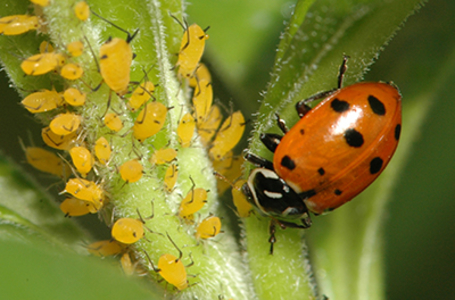Crop insects
Corn insects
Insects, diseases and nematodes affecting corn
Soybean insects
Insects and diseases affecting soybean

Find research-based information on both helpful and harmful insects, spiders and other insect relatives. Learn how to identify insect damage on plants and in the landscape as well as how to prevent and control common household insect infestations.
UMN Twin Cities is an affiliate of Bee Campus USA, an initiative of the Xerces Society that raises awareness of the importance of pollinators and actions each of us can take to help pollinators.
With no natural enemies indoors, inspect your houseplants weekly for insect pests like mealybugs and scale.
Scale insects are common on many trees and shrubs. Natural enemies help keep them in check but scales sometimes can injure plants.
Insects, diseases and nematodes affecting corn
Insects and diseases affecting soybean
Ants, bed bugs, clothes moths, cockroaches, flour beetles, springtails, wasps
Boxelder bugs, Asian lady beetles, flies, earwigs, masked hunters, springtails and stinkbugs
Pantry pests, carpet beetles, clothes moths and silverfish
Spiders, ticks, mites, millipedes, centipedes, scorpions and sowbugs
Bed bugs, fleas, head lice and medically significant insects
UMN Twin Cities is an affiliate of Bee Campus USA, an initiative of the Xerces Society that raises awareness of the importance of pollinators and actions each of us can take to help pollinators.
Visit the Bee Lab for information on helping pollinators
Grow bee lawns and pollinator friendly plants
Take this quiz and learn how your backyard could better benefit bees and other beneficial insects
List of plants for bee food and habitat
Social wasps and bees, stinging insects and how to get rid of their nests
Lacewings, lady beetles, minute pirate bugs, parasitoid wasps, syrphid flies
Four-lined plant bug, iris borers, rose chafers, spider mites, wasps and bees
Insects, spiders and other bugs that particularly help, harm or feed on fruits and vegetables in the home garden
Bluegrass billbug, cicada killers, cutworms, white grubs
Aphids, caterpillars, Japanese beetles, scales, sawflies
Black flies, mosquitoes and ticks
Identify insects in and around your home and yard
Plant diseases, insects pests of plants, control weeds
School IPM programs reduce pesticide applications and increase cost-effectiveness. Manage ants, rodents, wasps and bees.
Many yard and garden pests can be controlled successfully without pesticides.
Timely information to help you care for your yard and garden.
© 2024 Regents of the University of Minnesota. All rights reserved. The University of Minnesota is an equal opportunity educator and employer.